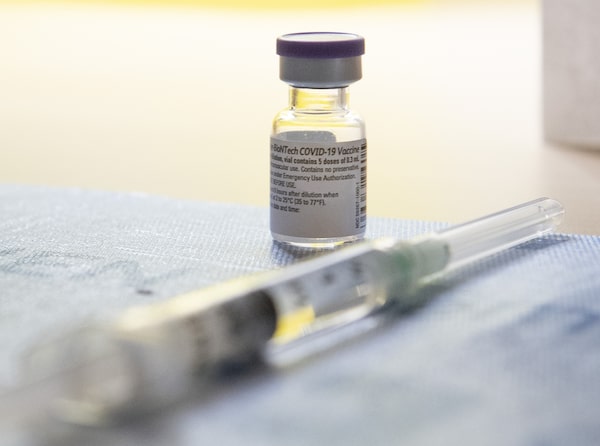
The first Pfizer-BioNTech COVID-19 vaccine dose in Canada sits ready for use at The Michener Institute in Toronto on Dec. 14, 2020.Frank Gunn/The Canadian Press
Sabina Vohra-Miller is the co-founder of the Vohra Miller Foundation, which aims to make health care equitable and accessible for all. Seema Marwaha is an internal medicine physician and editor-in-chief of Healthydebate.ca. Naheed Dosani is a palliative care physician and health justice activist who serves as a lecturer at the University of Toronto and an assistant clinical professor at McMaster University.
While high-risk Canadians are increasingly being vaccinated, it’s already clear that vaccine hesitancy will be a barrier to successfully immunizing the country. The deep-seated concerns of vaccine opponents regarding safety and government-mandated vaccine policies are unmoving, but such sentiments are typically of a small minority. Vaccine hesitancy, by contrast, is much more common and describes people who are undecided – anxious about safety or fearful because of the constant bombardment of misinformation online.
With only 57.5 per cent of Canadians saying they plan to be inoculated, now is the time to focus public-health communication efforts on vaccine hesitancy so we can curb the spread of this nasty virus. We need all hands on deck.
Prior to COVID-19, the fastest development of a vaccine was of one for mumps – and it took four years. Given the unprecedented speed of development, approval and distribution of various COVID-19 vaccines, public concerns have arisen as to whether due diligence has been done. Terms such as “Operation Warp Speed” have not helped. And decades of mistrust of pharmaceutical companies have compounded these concerns.
In BIPOC communities, many of which are disproportionately experiencing the impacts of COVID-19, vaccine hesitancy runs even deeper. The stains of Canada’s colonial past still traumatize Indigenous communities, who were subjected to experimental medical interventions and procedures without consent, including testing of the tuberculosis vaccine. The long, complicated and ongoing history of racism and discrimination in medical research has resulted in significant mistrust. Telling a racialized minority that Health Canada has reviewed the efficacy and safety of a vaccine and considers it safe is almost meaningless to a community that has lost trust in health care professionals, medical research and government.
Immigrant and multicultural populations are diverse groups with unique needs. For example, rumours of cattle products being used in the vaccines is contributing to hesitancy within the Hindu community. For Muslims, it’s important the vaccines are both pork-free and endorsed by religious community leaders. Pfizer, AstraZeneca and Moderna have confirmed their products do not contain pork gelatin.
What are some of the things the medical and scientific communities can do to counter this apprehension and skepticism?
First, we need to be more transparent about the scientific process used to develop the vaccines by better explaining how we have been able to utilize scientific innovation without compromising safety. It is important to tell the public that the mRNA technology of the Moderna and Pfizer-BioNTech vaccines is not new; it has been in development in various fields, such as oncology, for decades. Furthermore, it is important to explain that the rolling submission process that Health Canada uses to review data as it becomes available is safe and effective. Common misconceptions that these trials were rushed are simply unfounded.
We also need to be transparent about anticipated side effects. Pain at the injection site, fatigue, headache, muscle and joint pain and fever are commonly observed, as they are for almost all vaccines. These side effects are often mild and typically resolve in a few days. But if people are not expecting them, anecdotes about the vaccine making people sick can quickly proliferate, especially in online communities. We also need to inform the public that side effects from vaccination do not mean a person has contracted COVID-19 or can infect others.
Actively engaging in respectful, compassionate dialogue to validate people’s feelings and anxiety is paramount. It’s vital that we ask different groups what they are worried about, because if we don’t know what people’s concerns are, how can we address them? We can’t be dismissive of fears. We must be factual. Providing information that is accessible and easy to understand means not being sensational or using jargon. Shaming and blaming do not work.
We need to be strategic about whom we target in our messaging and how we target them. Only then will we be able to address the diversity of concerns we are hearing coast to coast to coast. Tailored trauma-informed messaging from trusted sources is critical. Government-sponsored content or content coming from large medical institutions may seem credible to one community but could feed mistrust in another.
Primary care health teams and community health centres already manage complex vaccine regimens with great success in terms of administration and education; they should be engaged. In addition, partnering with local community organizations and their leaders, who already have good relationships with the people they serve, is critical. These long-standing relationships allow for a better understanding of the unique challenges some communities are facing.
Culturally diverse and sensitive materials are imperative. We need content that is accessible, available in multiple languages and distributed on channels that target audiences regularly use. For instance, we could employ ethnic radio and TV to disseminate multilingual vaccine information or actively engage in Facebook groups or on Instagram.
The success of vaccine uptake in Canada will depend on a multipronged approach that addresses the unique needs of our diverse country.
Keep your Opinions sharp and informed. Get the Opinion newsletter. Sign up today.